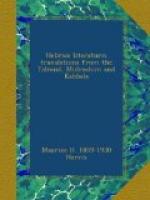Chullin, fol. 59, col. 2.
All this is as nothing compared
to the voice of Judah, which
made all Egypt quake and tremble,
and Pharaoh fall from his
throne headlong, etc.,
etc. See Jasher, chap. 64, verses 46, 47.
The distance from the earth to the firmament is five hundred years’ journey, and so it is from each successive firmament to the next, throughout the series of the seven heavens.
P’sachim, fol. 94, col. 2.
“Now, as I beheld the living creatures, behold, one wheel upon the earth by the living creatures” (Ezek. i. 15). Rabbi Elazar says it was an angel who stood upon the earth, and his head reached to the living creatures. It is recorded in a Mishna that his name is Sandalphon, who towers above his fellow-angels to a height of five hundred years’ journey; he stands behind the chariot and binds crowns on the head of his Creator.
Chaggigah, fol. 13, col. 2.
In the Liturgy for the Feast of Tabernacles it is said that Sandalphon gathers in his hands the prayers of Israel, and, forming a wreath of them, he adjures it to ascend as an orb for the head of the supreme King of kings.
The mount of the Temple was five hundred yards square.
Middoth, chap. 2.
One Scripture text (1 Chron. xxi. 25) says, “So David gave to Ornan for the place six hundred shekels of gold by weight.” And another Scripture (2 Sam. xxiv. 24) says, “So David bought the threshing-floor and the oxen for fifty shekels of silver.” How is this? David took from each tribe fifty shekels, and they made together the total six hundred, i.e., he took silver to the value of fifty shekels of gold.
Zevachim, fol. 116, col. 2.
Rabbi Samlai explains that six hundred and thirteen commandments were communicated to Moses; three hundred and sixty-five negative, according to the number of days in the year, and two hundred and forty-eight positive, according to the number of members in the human body. Rav Hamnunah asked what was the Scripture proof for this. The reply was (Deut. xxxiii. 4), “Moses commanded us a law” (Torah), which by Gematria answers to six hundred and eleven. “I am,” and “Thou shalt have no other,” which we heard from the Almighty Himself, together make up six hundred and thirteen.
Maccoth, fol. 23, col. 2.
David, we are told, reduced these commandments here reckoned at six hundred and thirteen, to eleven, and Isaiah still further to six, and then afterward to two. “Thus saith the Eternal, Observe justice and act righteously, for my salvation is near.” Finally came Habakkuk, and he reduced the number to one all-comprehensive precept (chap. ii. 4), “The just shall live by faith.” (See Maccoth, fol. 24, col. 1.)
The precept concerning fringes is as weighty as all the other precepts put together; for it is written, says Rashi (Num. xv. 39), “And remember all the commandments of the Lord.” Now the numerical value of the word “fringes” is six hundred, and this with eight threads and five knots makes six hundred and thirteen.




